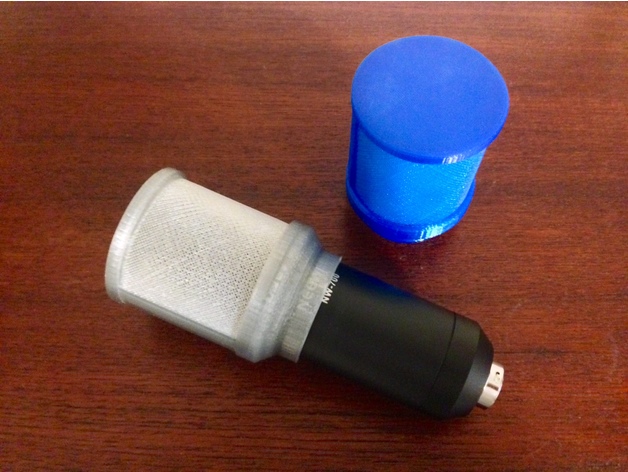
Compact Microphone Pop Filter / Sound Isolator
thingiverse
This is a compact microphone pop filter and sound isolator designed specifically for use with condenser microphones in voice chat applications. I created this device because my existing pop filter was cumbersome to set up and caused more problems than it solved. The back third of the casing is solid, which helps block out background noise from computers and typing keyboards. It works surprisingly well at isolating just my voice. To print the filter screen you will need to turn off solid infill on top and bottom in Cura's Expert settings. Use a larger number of shells to get around a 3mm border with a .4mm nozzle, and set the infill to at least 33%. I have found 45% to be pretty good. The housing of your microphone must be 44mm or less in diameter for this device to work, but it may be scalable to fit other size microphones. The top part of the mic should be around 50mm tall or less to fit under the cap. I've used this device with two different condenser mics I use for recording audio to my computer and it fits perfectly on both. Many microphones have similar dimensions, so it's likely that many will work with this device. Print Settings: Printer - Mod-T; Rafts - No; Supports - No; Resolution - .1 - .3; Infill - 25% +. Post-Printing: To ensure a smooth fit of the filter screen into the slots on the body and cap, use a sharp blade or sandpaper to remove any blobs or strings. If you're having trouble getting it to fit, try trimming it with scissors. If you're using a more brittle filament than PLA for the filter screen, you may need to warm it up in hot water before bending it so it doesn't break when assembling it. Overview and Background: I'm a music major who continues to work in a career involved with high school marching bands all around the country. I've always been fascinated by music and audio as well as how important sound is to creating any type of experience. This simple device was created to easily isolate sound directly into a condenser microphone while blocking out unwanted background noise and pops from speaking plosives. Lesson Plan and Activity: A simple way to demonstrate how audio is directional as well as its ability to be reflected. Using a compatible microphone, use a computer, tape recorder, or digital audio capture device to record someone speaking. Choose one or two test phrases to use, such as the "Harvard Sentences", which were designed specifically to test voice quality through audio devices. Record them once without the pop filter and again with it, comparing the sound quality of both. Repeat the test but this time add some sort of background noise like fans or typing on a keyboard, experimenting with microphone positioning and checking the results of how well the filter blocked out background sounds. Materials Needed: A microphone with a housing diameter of 44mm and recording screen no taller than 50mm; a way to record the signal from it, such as a computer, tape recorder, or digital audio recorder. Skills Learned: Audio, Recording, Sound, Electronics, Music.
With this file you will be able to print Compact Microphone Pop Filter / Sound Isolator with your 3D printer. Click on the button and save the file on your computer to work, edit or customize your design. You can also find more 3D designs for printers on Compact Microphone Pop Filter / Sound Isolator.
